There are a wide variety of incredible animals you may find along the Continental Divide Trail, including birds! In fact, hundreds of birds live along the CDT, with some sources estimating there to be over 300. Below, learn about 13 of the birds along the Continental Divide Trail, as well as how to identify them.
What Is the Continental Divide Trail?
The Continental Divide Trail is also known as the Continental Divide National Scenic Trail or simply the CDT. It became a United States National Scenic Trail in 1978. This trail spans from the northern border of the United States to the southern border, from Alberta (Canada) to Chihuahua (Mexico). It has a total length of 3,028 miles.

The Continental Divide Trail is a National Scenic Trail spanning the width of the western United States.
©R Kulawiak/Shutterstock.com
The CDT follows what is known as the Continental Divide of the Americas. This is a hydrological divide of the Americas, which helps discern what water flows into the Pacific versus the Atlantic, as well as discerning that of the Gulf of Mexico and Arctic Ocean. It covers five states of the United States, from Montana to New Mexico.
13 Birds Along the Continental Divide Trail
Thru-hiking the entirety of the Continental Divide Trail can take an average of around five months, depending on the hiker and their experience. As a result, you’re bound to see a variety of wildlife, including several different species of birds.
1. Golden Eagle

The golden eagle is one of the fastest birds along the CDT.
©Al Carrera/Shutterstock.com
Golden eagles (Aquila chrysaetos) are one of the most widespread eagle species. They are also one of the largest and fastest raptors located in North America. As a result, they can be an exciting bird to see, and they are one many people seek out along the Continental Divide Trail.
Although brown in appearance, these interesting eagles sport a gold sheen on the back of their head and neck. It is for this coloration that they are named. They are rather large birds with long wings. The base of their primaries are white, a sharp contrast to the warm brown of the rest of their body.
You may spot a golden eagle in both open and semi-open areas. This provides protection, areas to perch, and an abundance of prey. You’ll find that this species tends to avoid developed areas with no woodlands as well as wooded areas with no clearings.
2. Yellow-Billed Cuckoo
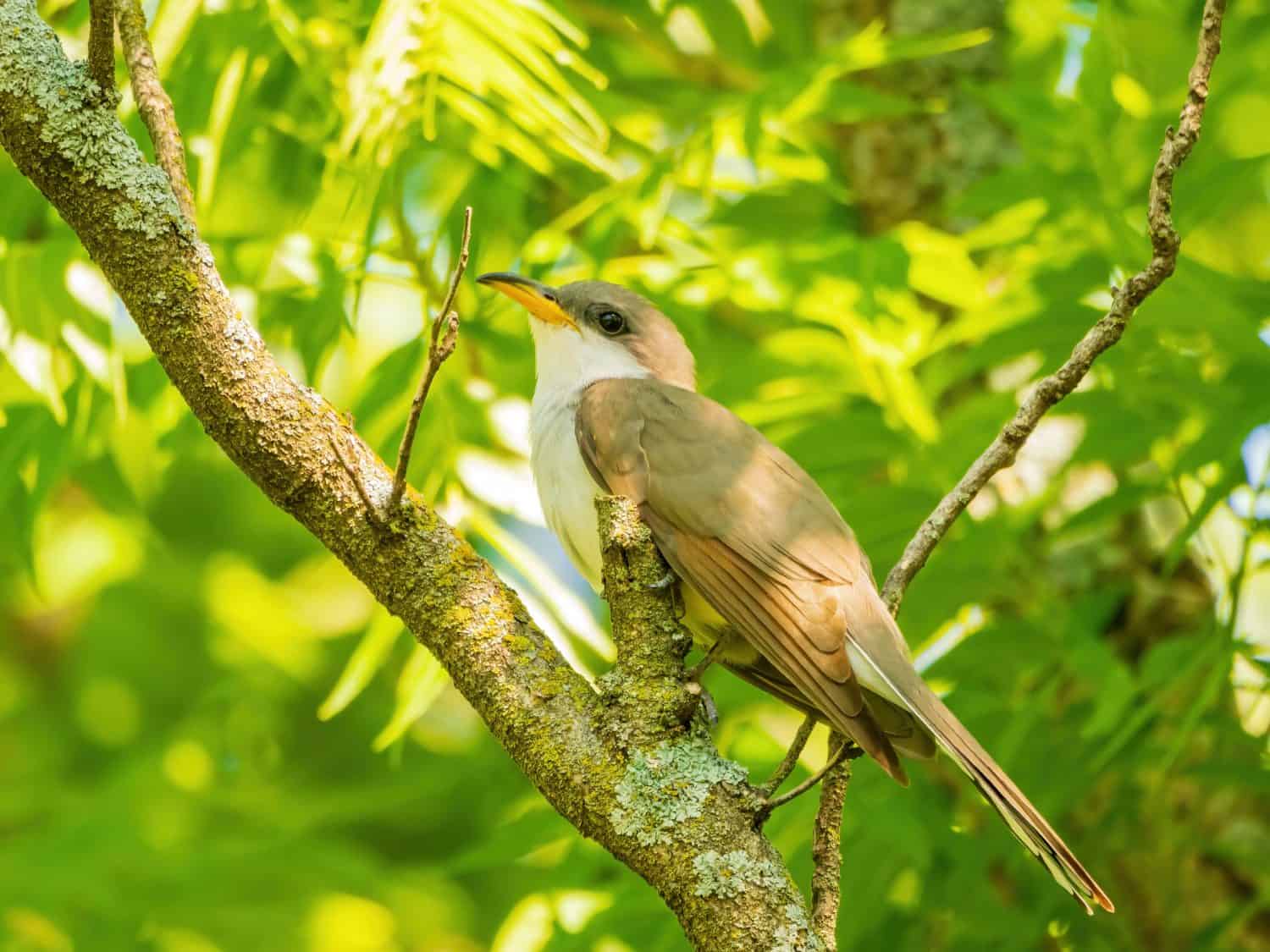
This bird is named for the color of its lower mandible.
©Kit Leong/Shutterstock.com
The yellow-billed cuckoo (Coccyzus americanus) is a rarer species found along the Continental Divide Trail. This is because they are a migratory species not commonly seen along the western region of the United States and Canada. However, large, uninterrupted areas of breeding grounds extend as far west as Texas, with many smaller regions dotting areas along the CDT.
In case you’re lucky enough to spot one of these birds along the trail during the spring and summer, you can best identify them by their namesake yellow bill. This yellow coloration is only found on the lower mandible, with the upper mandible sporting a dark brown or gray color. They have slender bodies with long tails. Their chests are white, with the dorsal side being brown. Aside from their yellow bill, you can also identify them by the large white spots on their tail.
3. American Crow
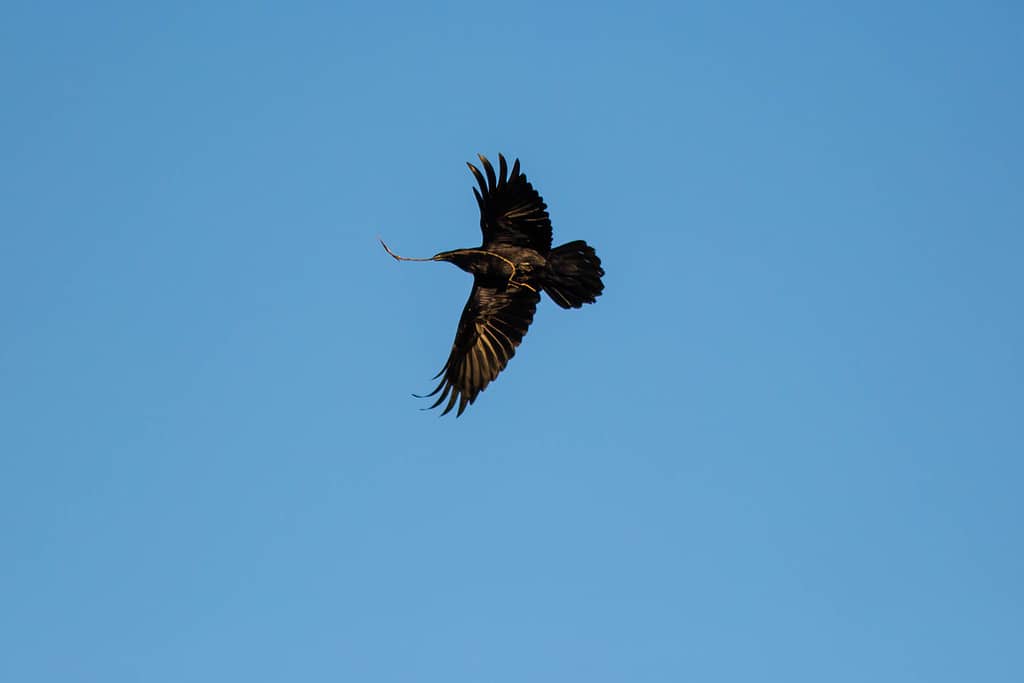
American crows are a migratory species on much of the Continental Divide Trail.
©Melissa McMasters from Memphis, TN, United States / CC BY 2.0 – License
The American crow (Corvus brachyrhynchos) is a staple species across the United States and Canada. In many areas, they are largely non-migratory. However, they may only be seen during the breeding season along the United States-Canada border. In select areas near Texas and California, they may only be seen during the winter.
These intelligent birds are a common sight, from rural forests to cityscapes. They can be best identified by their flying pattern, which features flapping with little to no gliding. They are smaller than the common raven, with short tails. American crows also sport long legs, stocky necks, and short, thick bills.
In certain areas, it can be difficult to tell the American crow from the fish crow. Because the fish crow is exclusive to the southeastern region of the United States, however, this shouldn’t pose much of an issue on the Continental Divide Trail.
4. American Three-Toed Woodpecker

This
woodpecker
has three toes instead of the usual four.
©Jukka Jantunen/Shutterstock.com
The American three-toed woodpecker (Picoides dorsalis) is a resident species in most of Canada and the northwestern United States. As a result, while you won’t be able to find these interesting little woodpeckers throughout the Continental Divide Trail, they can be more plentiful in the north.
This species is one of only three in the world that have three toes instead of four. While such a loss may seem detrimental, it is actually an advantage. This is because, with only three toes, the American three-toed woodpecker has the ability to lean further away from the tree. This then allows them to apply more force and hit the tree harder.
While a distinguishing feature, it may not be best to try and identify a woodpecker by their toes unless you have a good view. Instead, look for the male’s yellow crown. For males and females alike, you can also look for their black barring.
5. Bald Eagle

Bald eagles are most common near water because of their fish diet.
©Jack Molan/Shutterstock.com
The bald eagle (Haliaeetus leucocephalus) is the national symbol of the United States. It is also one of the birds that you may see along the Continental Divide Trail. Despite their name, these amazing raptors aren’t truly bald. Instead, they gain their name from the white plumage of their head, which can resemble a lack of feathers when compared to their brown bodies. This is especially true in flight compared to up close.
Bald eagles can be found throughout the entirety of the Continental Divide Trail. This is mainly during the breeding season. However, in select areas, such as Colorado, bald eagles are year-round residents.
These birds are most often found in wooded areas adjacent to sources of water. This is because the main component of the bald eagle’s diet is fish. While they will avoid living in developed areas, they won’t shy away from human infrastructure when hunting and feeding. As a result, you may see them swooping after fish near dams, where prey may be more prevalent.
6. Barred Owl

The barred owl can be found in the northern states that make up the CDT.
©FotoRequest/Shutterstock.com
Barred owls (Strix varia) are a popular species in North America that can be distinguished by their charming call. This hoot is often said to sound like, “Who cooks for you? Who cooks for you all?”
The barred owl’s initial range only includes the eastern regions of the United States and Canada. However, in modern times, they have slowly shifted west as well. They are not readily abundant along the Continental Divide Trail, but you can find them in the northern sections. This is especially true around Idaho and Montana. They are a non-migratory species, acting as a year-round resident in the areas they do live. However, because the great horned owl is a major predator of this little raptor, they will move to a different area if such a predator enters their territory.
If you’d like to increase your chances of spotting a barred owl along the Continental Divide Trail, look toward wooded areas near water. These owls prefer uninterrupted, mature forests.
7. Black Swift

Black swifts have angled wings for efficient, high-speed flight.
©Sokolov Alexey/Shutterstock.com
The black swift (Cypseloides niger) is one of the rarer birds along this trail. However, with its high flights and uniquely shaped wings, seeing one can be a rewarding experience.
Black swifts can be spotted everywhere along the Continental Divide Trail, although dependent on the seasons. These birds are mainly long-distance migrants, breeding in a small region in southwestern Canada and wintering in a small area in western Brazil. There are small breeding populations that may appear in the center of the United States., as well as a small year-round population in the Caribbean. As a result, your best chance to see these birds along the Continental Divide Trail is during their migration.
This species nests on cliff ledges and near waterfalls. It forages in forests and open areas. It can be difficult to see because it chooses to forage at heights where it is not visible or on cloudy days.
8. Bobolink
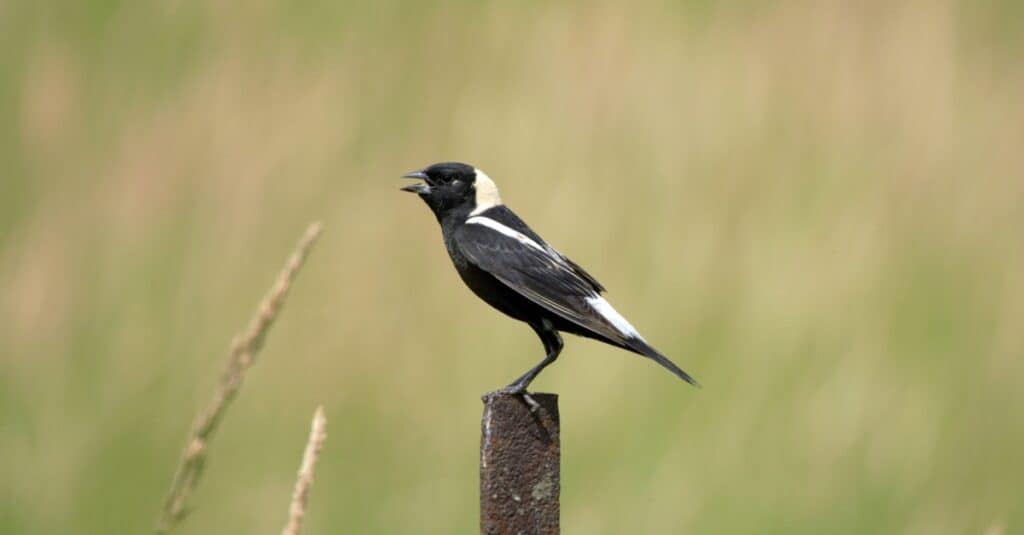
Bobolinks can be best identified by the male’s yellow cap and black-and-white underside.
©iStock.com/Carol Hamilton
The bobolink (Dolichonyx oryzivorus) is an interesting songbird with a bright appearance. They are the only species in North America to have black and white undersides that look much like a tuxedo worn backward. This coloration is only present in adult males, however, as is the yellow cap-like patch on top of their head. Females are instead a warm yellow with brown and white markings.
Bobolinks are dispersed across both North and South America. Along the CDT, they are most often seen in the north during breeding months. They migrate along the eastern coast, so they are less readily available during transition months in this area. They breed in open areas that feature a variety of vegetation. This species nests on the ground.
9. Gray Catbird

Gray catbirds are named for their cat-like call.
©Steve Biegler/Shutterstock.com
A residential species along the eastern and southeastern coasts of the United States, the gray catbird (Dumetella carolinensis), can be seen along the CDT during the breeding season. Then, during the winter, they will migrate to coastal regions in North and South America. The call of the gray catbird is memorable, sounding much like a cat’s meow. Along with this, thanks to them being closely related to mockingbirds, they are also able to perform mimicry, often performing pieces from other birds’ songs in combination with their own.
When looking for these birds along the trail, you’ll find that they nest in branches protected by dense vegetation. Because they may nest in shrubbery, these nests can be as close to the ground as 4 feet or as high as 60 feet.
Gray catbirds often forage on the ground, so you’re likely to see them hopping on the forest floor as well as flying. Like their relatives, mockingbirds, and thrushes, male gray catbirds are highly territorial. In addition to their territorial singing, they may puff themselves up to warn off rivals.
10. Great Blue Heron
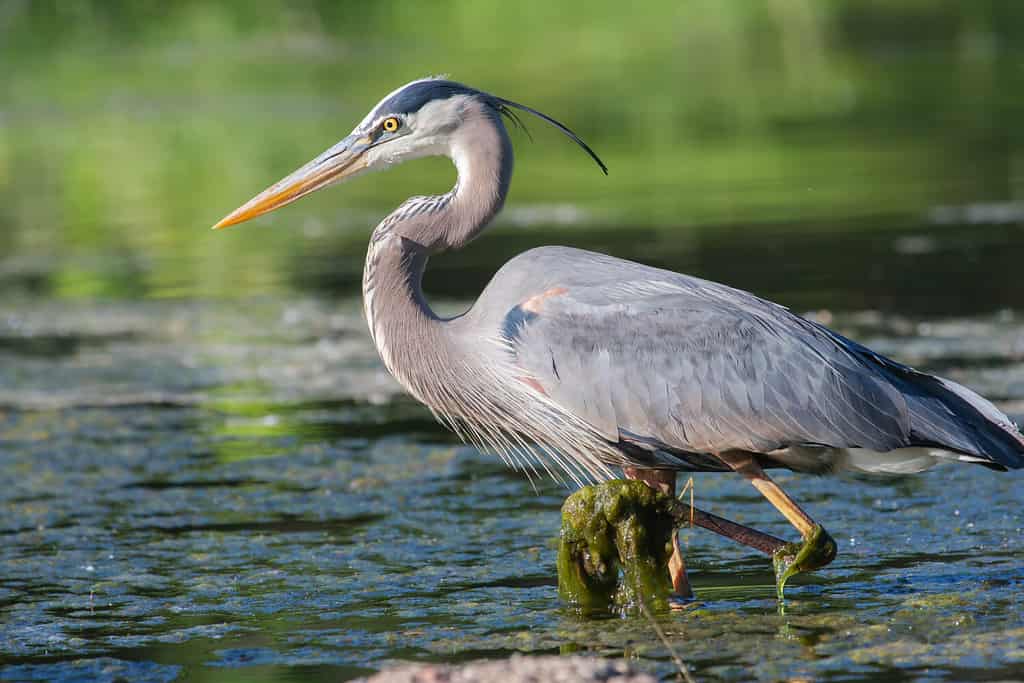
Great blue herons are found near or in water.
©Joseph Scott Photography/Shutterstock.com
Much of the birds on this list so far have been those that flock to forests and open fields. However, with so many water features along the Continental Divide Trail, it is important to also acknowledge some of the wading species found here.
The great blue heron (Ardea herodias) is both a residential species and a migratory species, depending on the area. In much of the United States, great blue herons are a year-round species. However, along much of the Continental Divide Trail, they are only seen in migration. This doesn’t include the southernmost extent of the trial in New Mexico, where they are residential.
Great blue herons are the largest of all North American heron species. They have long, bright orange-red legs with a long, razor-sharp bill of the same color. Their overall plumage is a gray-blue in color, with a pale head. They sport a large black stripe above their eye that often trails off into decorative feathers.
11. Zone-Tailed Hawk
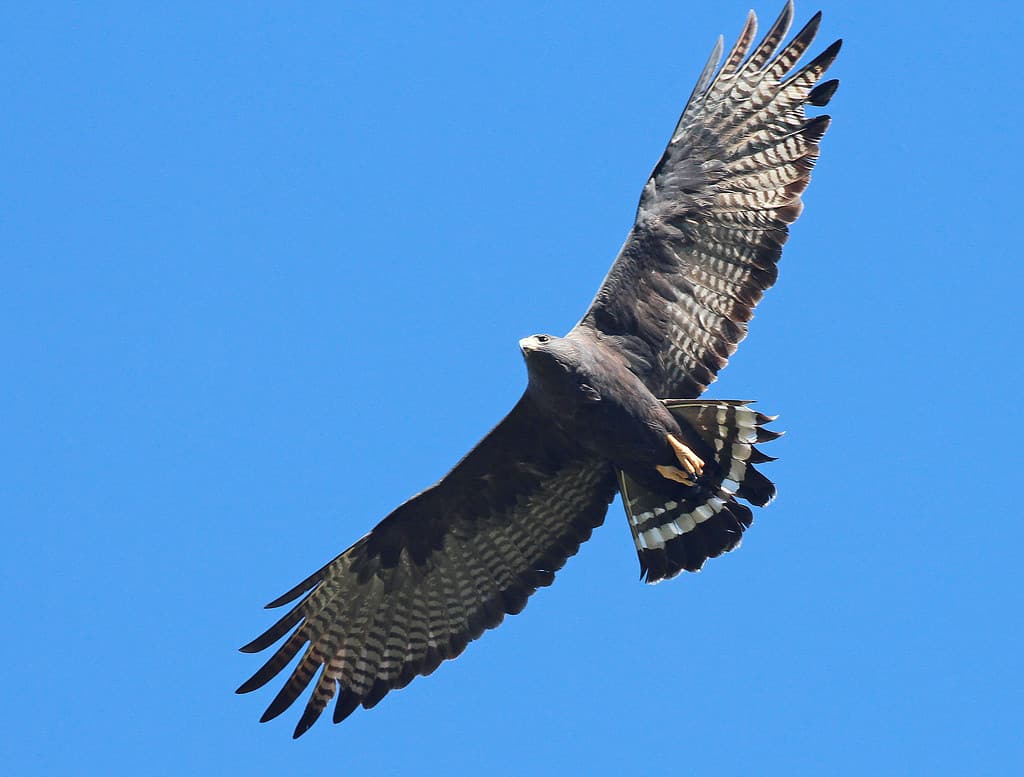
These hawks are found in the southern part of the CDT.
©ALAN SCHMIERER / CC 1.0 – License
The zone-tailed hawk (Buteo albonotatus) is an extremely rare species found only in small areas in New Mexico, Arizona, and Texas during the breeding season. However, luckily, their breeding range does collide with the southernmost extent of the Continental Divide Trail!
At first glance, the zone-tailed hawk may appear similar in appearance to the black vulture. However, closer inspection reveals that these raptors sport white bars on their otherwise black wings. They have the same bars on their tails, along with yellow legs and bills.
Because zone-tailed hawks are seen along the trail during the breeding season, you may have your best chances of seeing one by looking for their nests. Both the male and female of this species will work on building the nest. It is large, constructed of sticks, and often located high up in oak or pine trees. They may inhabit a variety of ecosystems within their range, from woodlands near rivers to desert scrublands.
12. Turkey Vulture
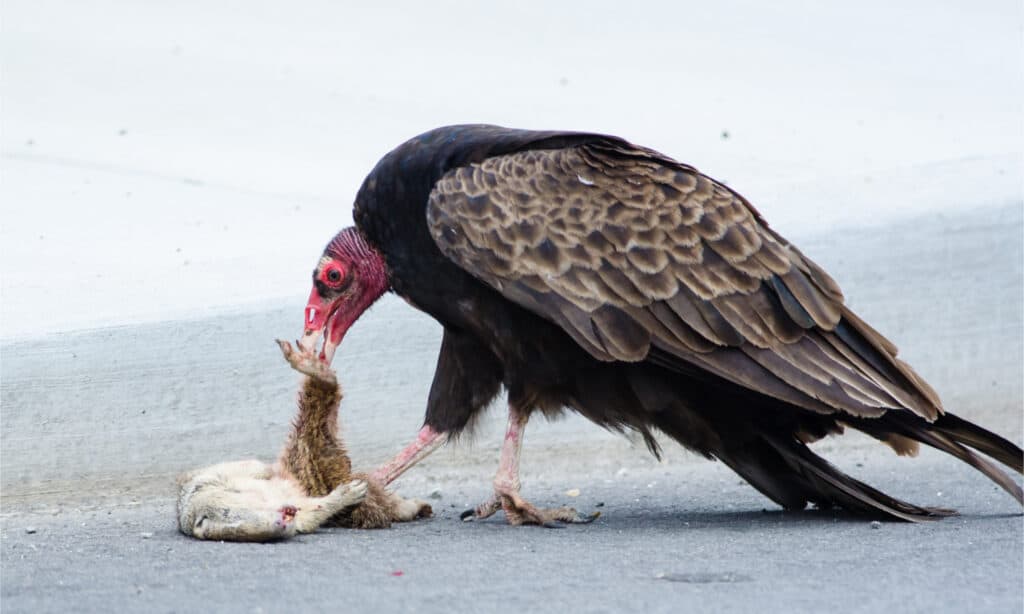
Vultures help keep the ecosystems around the CDT and continent clean and healthy.
©hubert999/Shutterstock.com
Turkey vultures (Cathartes aura) are likely one of the most widely distributed raptors in both North America and South America. For much of their range, the turkey vulture is a year-round resident. However, along the Continental Divide Trail, turkey vultures are typically only seen during the breeding season.
These large vultures sport the tell-tale bald head of most vulture and condor species. Their head is a bright pink or red color, while their legs are much paler. In flight, their long wingspan reveals white primaries. They often fly with their feathers outstretched in such a way that they resemble fingers. They will also fly with their wings slightly elevated in a “V” shape.
Although some may think poorly of turkey vultures, this species, along with all other vultures and condors, is essential to the health of our ecosystems. Vultures are designed in such a way that they are capable of removing bacteria and disease from the ecosystem in a way no other animal can. This is because their stomach acid is extremely acidic. As a result, they are able to effectively scavenge carcasses and return nutrients to the food chain.
13. Peregrine Falcon
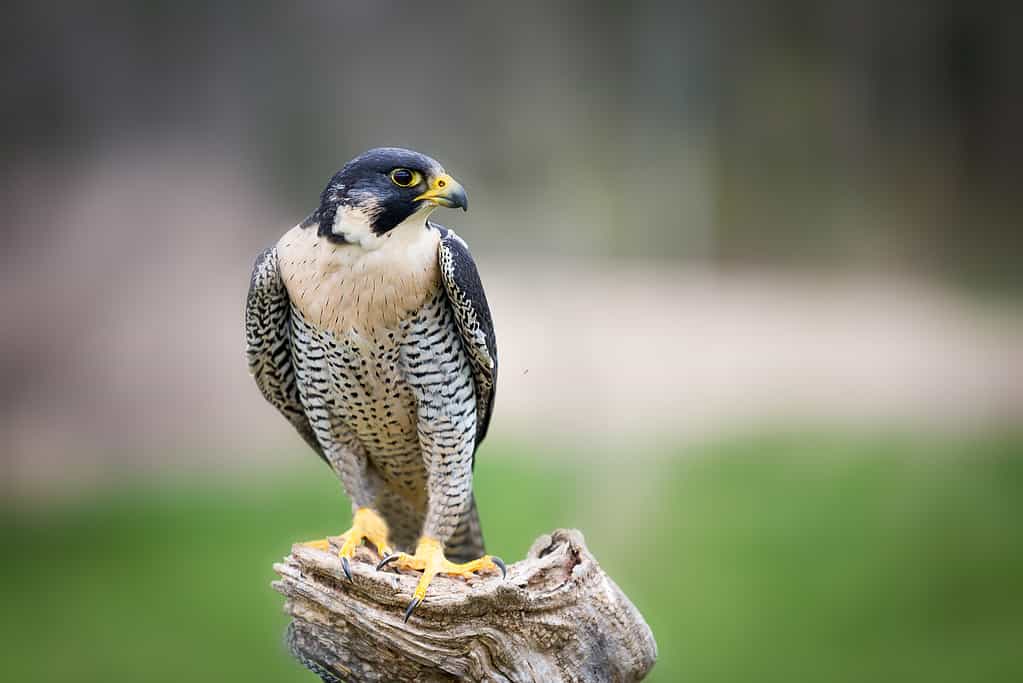
Peregrin falcons can reach speeds up to 200 miles per hour.
©emranashraf/iStock / Getty Images Plus via Getty Images
Did you know that the Continental Divide Trail is home to the fastest animal in the world? That’s right, you can find the peregrine falcon (Falco peregrinus) along this trail, both as a residential and migratory species. These birds are capable of reaching speeds up to 200 miles per hour when they dive for prey.
In the southern extent of the trail, peregrine falcons are a primarily residential species. In the north, they often are only seen during the breeding season. Throughout the rest of the Continental Divide Trail, these falcons are seen in migration, with small populations of breeding individuals and year-round residents speckled throughout.
The photo featured at the top of this post is © FotoRequest/Shutterstock.com
Thank you for reading! Have some feedback for us? Contact the AZ Animals editorial team.






